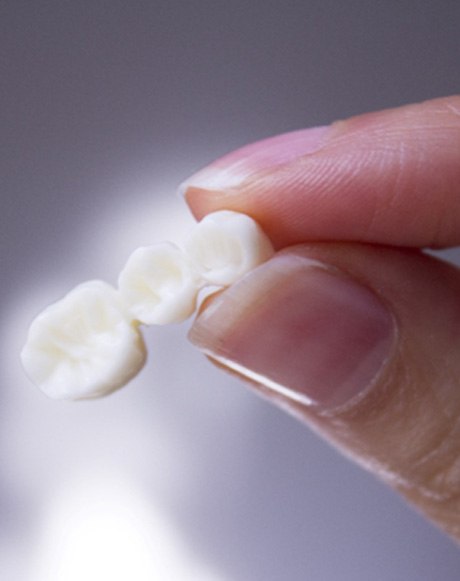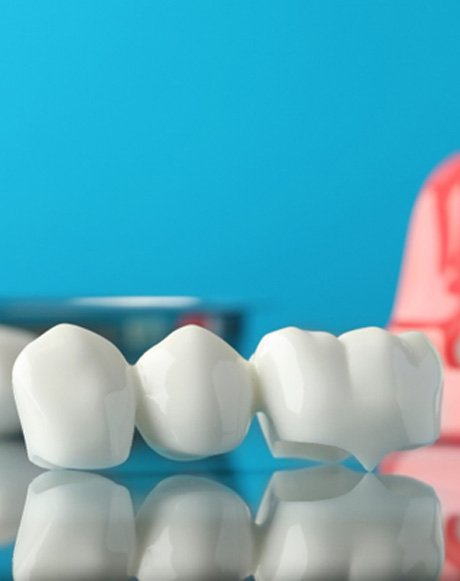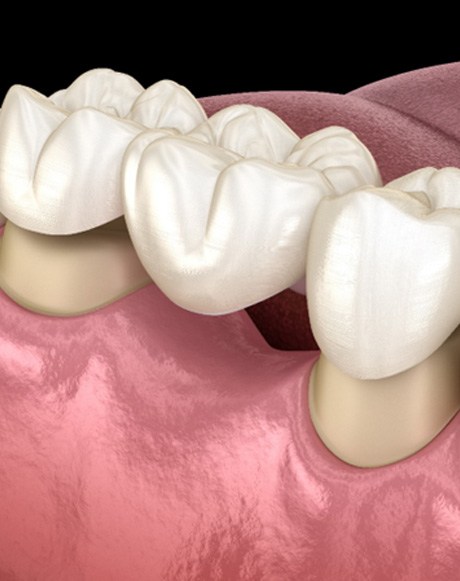Dental Bridges – Marysville, OH
Get Rid of Your Smile’s Gaps
Losing a natural tooth is never a good thing for an adult. When that happens, your grin’s looks worsen, and your oral health declines. Things get even worse if you lose several adjacent teeth. Still, there’s a good solution for that latter problem: dental bridges in Marysville! These devices can replace several pearly whites at once, given some help from Dr. Miller. Just keep reading to learn more or book a visit with our office soon.
What is a Dental Bridge?

A dental bridge is a fixed restoration for your smile. It usually consists of unique materials fused to either side of a pontic (i.e., a replacement tooth). Given that fact, it’ll often clasp onto your other natural teeth for support.
The best dental bridge candidates are patients who’ve lost several adjacent teeth. After all, they can often restore their smiles with a single treatment. Most adults can qualify for dental bridges otherwise. So long as your oral health is good, they don’t have strict requirements.
The Types of Dental Bridges

You must consult our dentists before a bridge treatment. That way, they can assess your smile to see if the procedure might help. They’ll gladly draft a custom treatment plan if they believe a dental bridge suits you.
Once they’ve examined you, our dentists will suggest one of two types of bridges. These kinds are:
Traditional Dental Bridge
A traditional dental bridge is the more well-known kind. For years, it’s been made of a replacement tooth fused to two (or more) dental crowns. It thus relies on nearby natural teeth – “abutments” – to keep itself in place.
The traditional bridge is often the less expensive type. However, a dentist can only place it by altering your tooth structure. That means they must remove some enamel from your abutments.
Implant Bridge
An implant bridge (per its name) is a type that uses dental implants. These latter restorations are directly placed in your jawbone and slowly fuse with it. By doing so, they ensure the bridge connected to them is firmly rooted. The final appliance won’t loosen or fall like other prosthetics can.
Thankfully, an implant bridge doesn’t alter your tooth structure. The dentist won’t need to “prep” abutment teeth to place it. In exchange, this bridge tends to cost a bit more.
The Benefits of Getting a Dental Bridge

No matter the kind, a dental bridge has many benefits. The most common ones are:
- Straighter Teeth – Smile gaps tend to make your other teeth tilt over time. Dental bridges fill those gaps, thus ensuring these pearly whites don’t shift. Your grin should then stay nice and straight.
- A Lifelike Smile – Dental bridges use porcelain for their material, so they blend seamlessly with your smile. Your peers won’t even notice you have one!
- A Healthier Mouth – By filling your smile gaps, a dental bridge will deprive harmful bacteria of breeding grounds. You’ll then have a greatly reduced risk of oral problems.
- Enduring Results – The average dental bridge lasts roughly 15 years or so. Meanwhile, an implant bridge can reach an even longer lifespan with proper care.
Should you lose adjacent teeth, a dental bridge can restore your grin. So, book a visit to our office really soon!

